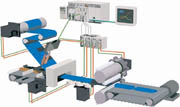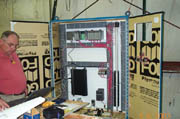
Suppliers of automation hardware have reconsidered the earlier assumptions. Unlike PC-based controls, PLCs are familiar, battle tested, reliable controls of plant floor devices. As their flexibility and functionality have increased, prices have declined.
"Everybody was promoting PC-based controls, but the dogs didn't eat the dog food because we basically tossed a PC control at plant engineers and said, ‘Have a nice day,'" suggests Mike Miclot, marketing manager for Rockwell Automation's ControlLogix line. "PC architecture posed problems in start-up phase. The operating system had to be integrated with existing systems, software had to be installed and harmonized, and everything had to be fine-tuned. Assuming you got through that, if something happens after it's deployed and operational-maybe IT wants to shut down the system to install a new Norton antivirus-then you have to reengineer it again."
Another critical shortcoming of the PC is its obsolescence cycle. "On the plant floor, it comes down to what can you support in terms of spare parts, and a PC purchased today won't be available in five years, yet the machine it controls will be here for 15," points out Joe Biondo, marketing manager of electronic drives and controls at Bosch Rexroth. "If you're the end user, you don't want to be a controls builder, but that's what you would have to be if the CPU, RAM and internal bus in your controls would not be supported in a few years."

Slimmer, trimmer cabinets
PC attributes such as Ethernet connectivity and e-mail capability have been incorporated into the traditional PLC, and functionality can be expanded with "standard media cards that you buy at Best Buy," Rockwell's Miclot says. More significantly, platforms for sequential, logic and motion control can be packed into a single control, significantly slashing setup time.That was Pepperidge Farm's experience with its Bloomfield, Conn., facility, this year's Food Engineering Plant of the Year (see April 2004 issue). ControlLogic hardware represents three-quarters of the 39 PLCs deployed throughout the bakery. Consolidated platforms and open network design reduced integration and debugging costs to half those for the company's previous new-plant project, estimates David Watson, Pepperidge's vice president of engineering, and system expansion will be easier and less expensive. Device tags with easily recognized names are becoming the norm in PLC technology, and that also contributed to project economies.
"Engineers love having one CPU that executes both sequencing and motion," says Miclot. "It saves panel space, spare parts and documentation, and it improves performance. Processing speed is magnitudes greater than one or two generations ago, moving from micro seconds to sub-microseconds."
At the same time, the proprietary walls around PLCs are crumbling, an important development for both greenfield projects and retrofits. Greyston Bakery, a Yonkers, N.Y., processor that moved into a new facility in March, has an automation architecture that would have been considered unmanageable years ago: Siemens PLCs control bulk ingredient delivery and mixing processes, while Allen-Bradley controls regulate all equipment from makeup through packaging. "We can't program the Allen-Bradley controller, but both Siemens and Allen-Bradley support open-bus communications networks," notes Christian Kurtz, product marketing manager for PLCs and industrial software at Siemens Energy and Automation. "We don't want to develop proprietary programs; openness to the other side is very important."
Compatibility is being helped along with conformance to the International Electrotechnical Commission's 61131-3 language, an international standard that virtually all the major automation suppliers support. Siemens and the others also support traditional ladder logic programs. Unilever has been lobbying suppliers to support basic, reusable code to speed integration. Modularity of software complements modularity of PLCs, Kurtz points out, and Siemens is supporting Unilever's initiative with its IMAP software program. The idea is to define common objects such as ovens, conveyors and mixers, then reuse those object codes at other facilities. When the system is configured, objects are dragged and dropped, and Imap graphically links the hardware and its functions on screen.
PLC modularity is illustrated with the safety controls that now can be integrated into the same device that manages logic and motion, says Kurtz. Siemens released the integrated safety controls last year. "It's a great success," he says. "Combining all the e-stops and safety gates into the same controller saves much more than hardware costs. At the end of a project, program code development is a much bigger cost," and those costs disappear with a certified safety controller on board.
The company's S7 series of controls offer varying degrees of complexity, depending on the application, and a mix-and-match approach lets users customize their PLCs to an extent. The S7-300 unit for mid-range applications can handle 2,000 I/Os, with memory to match, explains Kurtz, but if greater computing power is needed, the S7-400's 20 megabyte CPU could be placed in the unit.
"Speed is important, but so is consistency," says Jon Giardina, automation market manager with Omron Electronics LLC, the Schaumburg, Ill., subsidiary of advanced electronics and control system supplier Omron Corp. When the coordinated motions of a high-speed bottling line must be controlled, fluctuations in the rate at which commands are executed can cripple the operation. "Our hardware processes in the 5.6-6.2 millisecond range consistently," he says.
Best of both worlds
Like other PLC providers, Omron is focusing on machine safety and traceability support. The ability to store and tabulate data in the controller is being strengthened, Giardina says, and that reduces workloads higher in the automation architecture. For small and mid-sized plants, removable compact flash cards are an alternative to Ethernet networks for retrieving data from floor devices, "a real advantage," he adds."Manufacturers took all the things that are good about PCs and incorporated them into PLCs: data handling ability, data acquisition ability, computational ability," says Giardina, "and it's in a very rugged, solid-state design."
Ruggedness is essential to survive the industrial environment, and considerable time and expense is devoted to the cabinetry surrounding rack systems. Food engineers who want to have their PLC cake and eat it, too, can opt for a PLC card that plugs into a PC. "By installing a PLC kernel under the Windows kernel, you get the stability of a rack system and avoid trashing your old architecture," says Bosch's Biondo.
Considerable confusion exists over the multiple brands of Schneider Electric, the multinational electronics giant that wrestled with acquisition issues for most of the last decade. On the PLC side, the company is bringing the Modicon, SY/MAX and Telemechanique brands under the Telemechanique umbrella, though the Modicon and SY/MAX identities will be maintained for the foreseeable future, according to Brian Owens, Schneider's market segment manager for food, beverage and pharmaceutical. Seven tiers of sophistication exist in the PLC lineup, from compact units to the advanced Advantys STB modular I/O platform and power management system.
Square D introduced the SY/MAX line 26 years ago. A huge installed base exists. "Instead of getting rid of SY/MAX and other mature lines, we've continued to support them and have created an easy migration path when plants want to upgrade their controls," says Owens. "The real cost when upgrading an old PLC is the I/Os, not only the cost of the hardware itself but rewiring and checking all the points, then revalidating them." Those costs are avoided, thanks to continued support of SY/MAX, Modicon and older Telemechanique units, he says.
While he agrees today's controls are faster, more powerful and more economical than previous generations, Owens points to "ease of configuration as the key change." Reconfiguration of micro, premium and quantum classes of Telemechanique PLCs got a lot easier recently with release of Factorycast HMI. Browser-based monitoring and reprogramming of controls are accomplished in a secure environment without an investment in scada nodes and database services, eliminating the need for costly custom software. "If you have to alter the stop/start ramp on a VFD, you can do it with the browser instead of a proprietary network," says Owens. "Now you're in the Windows or Oracle world, where information is inexpensive and easy to get to."
The orbits of the PC and PLC worlds increasingly overlap, and distinguishing between their trajectories is becoming an academic pursuit. Whatever meaningful distinctions remain, it's certain that the features and benefits that made PLCs a staple of plant automation will remain a fundamental part of control hardware.
For more information:
Dan Throne, Bosch Rexroth,847-645-3749,dan.throne@boschrexroth-us.com
Debbie Prickett, Emerson Process Management,
512-832-3288
Dennis Dearth, ESYNC,
419-842-2210, ext. 12
Jon Giardina, Omron Electronics,
847-843-7900, ext. 264
Mike Miclot, Rockwell Automation,
440-646-4053
Brian Owens, Schneider Electric North America,
847-922-8571, brian.owens@us.schneider-electric.com
Christian Kurtz, Siemens Energy and Automation,
770-871-3855, christian.kurtz@siemens.com
Revenge of the PLC
PC-based controls may one day replace PLCs, though few of today's food engineers are likely to live to see that day. In the meantime, PLC technology not only is holding its own, it's sometimes replacing PCs.
That was the situation at J&J Snacks Foods Corp., which implemented a warehouse management system at its Pennsauken, N.J., facility last year. A fly in the WMS ointment cropped up when the project reached an existing pallet flow rack staging and storage system in J&J's freezer. A "homegrown PC" programmed by an engineer who "was long gone" controlled the system, and "nobody knew how to get the WMS information to the PC" on pallet placement, recalls Dennis Dearth, technical services practice leader at ESYNC, Toledo, Ohio. The firm is an integration partner of Highjump Software, the logistics management firm that installed J&J's WMS.

"We needed an organization that knew not only controls, but that also had applied experience with the Highjump product," Heffelfinger explains. It took ESYNC about three weeks to build a heater-equipped PLC cabinet, install RSSql to integrate the PLC data with the WMS and RSLinx as the communication server, then start up the system.
"Without those two pieces of Allen-Bradley software, it would have taken a fair amount of time to write the interface program and PLC code to the flow racks," Dearth says. Those types of integration hang-ups are becoming a thing of the past, and that favors the PLC's survival as a reliable, well-understood piece of automation architecture.